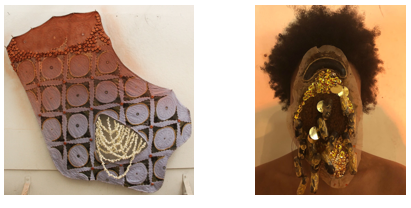Batik Textiles
What is batik?
Batik is a wax resist technique for textiles. Wax is applied to fabric with a stamp, brush, or specialized tool
Batik originated in Indonesia and has been designated by UNESCO as a Masterpiece of Oral and Intangible Heritage of Humanity.
Source
Batik and other forms of textile wax resist also have a strong tradition in Africa. Some of the earliest examples of batik can be found on wrappings of Egyptian mummies.
Studio Artist Spotlight: Textile Arts
Myra Greene creates hand dyed cloth with screen printing. Myra’s work uses colors and patterns
of African textiles to explore her own relationship to culture. Myra created a series of works using complementary colors to create shades of brown to celebrate blackness without the body.
KKelly Taylor Mitchell’s work centers on oral histories woven into the fabric of the Africana Diaspora. Kelly creates masks and performative objects that she hand dyes, sews, and adorns with objects and patterns using many different techniques.
Materials
• Slow cooker or pot that you DO NOT use for cooking
• Beeswax or reclaimed wax from candles or crayons
• Clean, washed cotton textiles
• Newspaper, newsprint, or paper sacks
• Iron and ironing board
• Sponge brush, paintbrush, corks, or other heatproof tools for mark making
Step 1: Melt and apply wax
• Melt beeswax in a slow cooker or small pot (THAT YOU DO NOT USE FOR COOKING)
• Lay your clean, washed cotton textile on a protected work surface
• Use a sponge brush or paintbrush to paint on wax in your desired motif. Or use natural corks, metal stamps, or other heatproof tools to stamp on wax.
**Tip 1: If working in a small batch heat wax within a heatproof cup your pot or slow cooker
**Tip 2: Keep your tools warm within your slow cooker to prevent wax hardening on your tools between uses
Step 2: Dye your textiles
• Allow wax to dry completely.
• Fully submerge your textiles in dye.
**Want to make your own dye? Check out our tutorial on creating dye from foraged natural materials here
• Place dyed textiles in plastic bags and let sit overnight.
• The next day, rinse out excess dye and let air dry completely.
Step 3: Remove wax
• The wax has resisted the dye and preserved the original color of your textile underneath.
• Place an old towel on your ironing board (or other heatproof surface) to ensure it is protected from wax.
• Place your textile down on the protected surface. Cover with flattened paper bags, newsprint, or newspaper and begin ironing.
• Continue ironing and replacing newsprint until all wax has melted out of the textiles.
• Wash and dry normally before using.
Step 4: Share your work!
We love seeing how you use these prompts in your artmaking practice! Use the tag #ACMakes on social media to share your creations with us!












